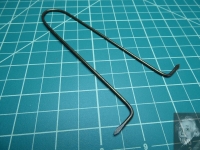Doesn't get much simpler than this, as tools go.
Anyone who owns a lathe with a threaded spindle knows that it's important to keep chips and swarf out of the chuck threads. It's just too easy for the stuff to get between the chuck and the register and spoil the chuck centering. Worse yet, it's not impossible for it to jam the threads and make the chuck very difficult to remove - a recipe for a broken back gear if you don't use the proper tools to remove a stuck chuck.
Take a piece of coat-hanger wire and bend it into the shape shown below. If you don't have coat-hanger wire [How could you not? The damn things breed in closets.] use something similar. The wire needs to be mildly springy. Flatten the ends and grind them into the shape shown in the second photo.
In use the device is threaded into the chuck jaws all the way down to the runout groove at the bottom of the threads. Swarf and chips are dislodged and fall into the bottom [or fall out if you hold the chuck over your head] where they can be wiped or better vacuumed. [Remember, compressed air is a tool for relocating swarf to the place where it can cause the most damage. ]
After you've cleaned the chuck threads, it's a good idea to clean the swarf out of the chuck jaws and scroll plate. Backing the jaws out of the chuck will be less tedious if you make a crank or use your electric screwdriver as detailed here...
http://www.homemadetools.net/forum/s...uck-jaws-26219
Once the jaws are out and cleaned, the scroll plate can be cleaned as follows. Push a toothbrush down into one of the chuck recesses so its bristles engage the scroll plate thread. Turn the scroll plate in the direction that would back the jaws out if they were in place. [The electric screwdriver really helps here.] Because the toothbrush is "engaged" in the scroll threads it will be driven outward, collecting swarf on its leading edge as it goes. Continue until the toothbrush completely disengages from the threads and the swarf will drop away onto the bench. If the toothbrush is an old oily one like mine, this procedure will also lightly lubricate the scroll.
One important safety warning: Do not, under any circumstances, return the toothbrush to the bathroom rack.
Bonus hint:
Folks with threaded spindles should thread a length of rod with the same thread as the spindle. Cut off a chunk and put it aside to use as a proof piece for turning female threads on accessories that will thread directly onto the spindle. One of these accessories should be a cap used to protect the spindle thread when no chuck is mounted.
Screw another chunk to a piece of plate. Put holes in the plate for attachment to the rotary table. With this in place, attaching the chuck to the RT is dead simple. Also, the chuck can be easily mounted to the milling table for jobs that might benefit from such an arrangement.
It may be possible to make a more upscale chuck thread cleaner using another chunk of the threaded rod. I haven't given it a lot of thought (because my coat-hanger wire works just fine) but by suitably shaping the end thread it should be possible to make a "bulldozer" that pushes swarf ahead of it. Think about it.


 LinkBack URL
LinkBack URL About LinkBacks
About LinkBacks




 Reply With Quote
Reply With Quote




Bookmarks